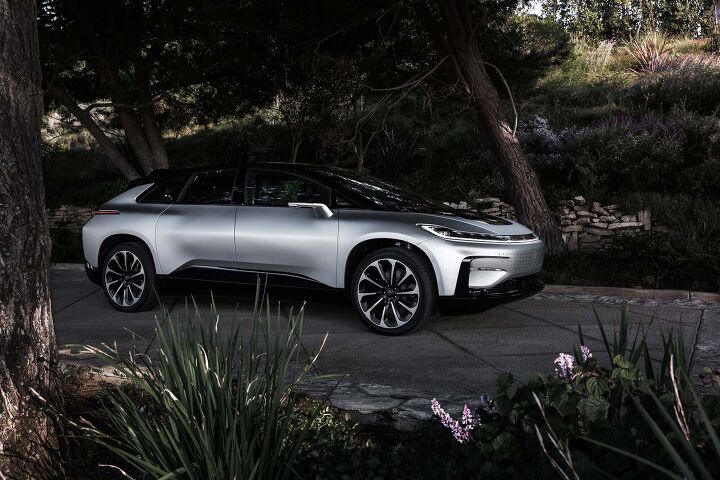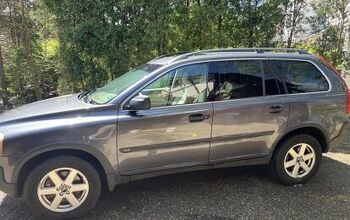Faraday Future FF 91 Fancily Flails for Journalists at Monterey

Faraday Future was keen to show off its EV crossover during high-profile events at Pebble Beach a couple weeks ago. Nearly ready for production, Faraday says customers who have ordered the FF 91 could receive their vehicles by end of year. Given the CUV is so far along in its development, journalists were allowed to ride along in the super luxurious (and expensive) FF 91. Unfortunately, it didn’t go well.
Monterey, California is the annual host of the Pebble Beach Concours d’Elegance. It’s where the wealthiest car lovers from America and beyond gather to show off their facelifts and give trophies to multi-million dollar antique cars that can’t be touched and shouldn’t really be driven. The Concours is but one of several events during Monterey Car Week, a tradition that evolved from a single car race in Monterey in the Fifties.
It was in this lush, luxurious setting that Faraday Future decided to give journalists seat time in the FF 91 (pronounced nine-one, not ninety one). Faraday makes some big claims for its high-end crossover, which will have a base price of $182,000 at debut. For that money, buyers will experience a well-made, four-seat EV crossover with a very low ride height, a lengthened, bulbous shape, and a profile similar to a DayQuil gelcap. Faraday calls the design “future-forward.” The target customer is not the common CUV buyer, but those who want a luxurious passenger-oriented four-seat chauffeured limo.
The FF 91 rides on Faraday’s modular platform which they call VPA, or Variable Platform Architecture. Faraday has patented a new invention to power its VPA vehicles, the FF Echelon Inverter. An interesting bit of technology, the inverter differs from those used in other EVs. Faraday’s is a ground-up design with a fewer number of required transistors and less complex componentry.
Faraday says the design has greater stability, is more dependable, and less expensive to make. The company claims the inverter allows for a new level of power density, which means it’s able to transform energy in a more efficient way and take up less space doing so. The Echelon Inverter reaches between 20 and 30 percent greater power density than inverters in EV competition.
Faraday made sure to design their inverter to be future-proof, as it’s able to manage power levels far greater than any EV presently on the market. They patented the inverter in 2016, and its usage in the FF 91 is in conjunction with the vehicle’s three electric motors. Combined, Faraday says the FF 91 has 1,050 horsepower, and the crossover reaches 60 miles per hour in 2.39 seconds.
Blistering performance, then. The FF 91 also promises over 300 miles of theoretical range per charge. That’s slightly less than the 348 miles of range provided by the closest competition, the Tesla Model X. And of course the Model X has already been on sale for eight years (time flies)!
Faraday intends to provide a more personal experience than Tesla, by including AI in all its vehicles. The FF 91 works with a customer’s Faraday Future profile (FFID), which tracks preferences for driving and overall content selections. The crossover recognizes an approaching driver, and then adjusts itself to suit. The company says “...the more you use the FF 91, the smarter about you it becomes, delivering a truly bespoke experience.” Ever seen Black Mirror?
The FF 91 parked in Monterey attracted quite a bit of attention from onlookers who wanted a peek inside the Faraday. Unfortunately there are no exterior door handles on its coach-style doors, as door operation happens via key proximity or the crossover’s accompanying app with its FFID. Hopefully the company has addressed the need for emergency outside access from a non-Faraday owner, say in a crash situation.
A journalist from Forbes was on-hand at the parking lot of Pebble Beach, where the Faraday experience began. The company brought two examples of the FF 91, one of which was used for test drives. Journalists were not allowed to drive the pre-production 91, and instead rode along as passengers. Issues began as soon as entry was granted into the luxurious interior.
Screens abound in the FF 91, and include a large central tablet that’s roughly the size of the order kiosk at a McDonald’s. There are also screens in the door panels that replace buttons normally found in that area. The front passenger is granted an additional screen for entertainment purposes or to make video conference calls.
Gauges are displayed on another screen for the driver, and the central rearview mirror is a screen. The rear has similar door panel screens, and includes another larger screen attached to the rear center console. There’s another screen spanning across the ceiling for rear seat passengers. That screen is movable for rear visibility purposes, but the journalist found when she attempted to move it that operation caused a lot of grinding noises. There was also a moment where the screen stopped moving entirely.
Rear seats are of the reclining variety, and Faraday advertises they’re zero gravity and designed to NASA Neutral Body Posture specifications. Unfortunately on the day of the test, the posture specified was Nap Time: The FF 91’s rear seats were in two different states of heavy recline. Seat settings were found on the front central touchscreen, but it turned out neither seat adjustment was functional.
All the aforementioned touchscreens are Android-powered underneath, but Faraday put their own programming on top like many manufacturers. Journalists attempted to use a few common Android voice commands, but the system was unresponsive. Doors were supposed to open via voice command, but the touch screen ended up being the only way to make the doors work.
Journalists were taken on a short driving loop near the golf course, but copious high-dollar traffic generally limited the experience. On one open stretch the driver took an opportunity to punch it, but the FF 91 felt much less than capable of its claimed 2.39 seconds to 60. Uh oh. Faraday won’t comment on its engine arrangements beyond the claimed stats on the company website.
Supposedly, all kinks will be worked out in the final quarter of the year. In June, the company CEO said he expected to build 400 cars by the end of 2022. And that timeline does track with what the company stated in late July.
However, that same paper (a filing with the SEC) included a more concerning bit too: “The company needs additional cash to commercially launch the FF 91 and is currently seeking to raise additional capital to fund its operations through December 31, 2022." Hopefully that capital will get the seat buttons working again.
[Images: Faraday Future]
Become a TTAC insider. Get the latest news, features, TTAC takes, and everything else that gets to the truth about cars first by subscribing to our newsletter.

Interested in lots of cars and their various historical contexts. Started writing articles for TTAC in late 2016, when my first posts were QOTDs. From there I started a few new series like Rare Rides, Buy/Drive/Burn, Abandoned History, and most recently Rare Rides Icons. Operating from a home base in Cincinnati, Ohio, a relative auto journalist dead zone. Many of my articles are prompted by something I'll see on social media that sparks my interest and causes me to research. Finding articles and information from the early days of the internet and beyond that covers the little details lost to time: trim packages, color and wheel choices, interior fabrics. Beyond those, I'm fascinated by automotive industry experiments, both failures and successes. Lately I've taken an interest in AI, and generating "what if" type images for car models long dead. Reincarnating a modern Toyota Paseo, Lincoln Mark IX, or Isuzu Trooper through a text prompt is fun. Fun to post them on Twitter too, and watch people overreact. To that end, the social media I use most is Twitter, @CoreyLewis86. I also contribute pieces for Forbes Wheels and Forbes Home.
More by Corey Lewis
Latest Car Reviews
Read moreLatest Product Reviews
Read moreRecent Comments
- Tassos No, because I am not one of these idiot fanatics who buy a new model in its first year of production, bugs and all (not to mention they usually are charged a stiff premium over MSRP from their greedy Dealer-Stealer)
- HotPotato The Ariya's trim levels are so confusing that they should also hire a navigator to walk the customer through how to get the car they want. Or an online configurator where you check off the things you want and it leads you to whichever obscure version offers them (if GM can do it, why can't Nissan?). God help you if you have a simple request like "I just want the tan cloth interior and Bose, which model offers that?" The website can't help you and neither can the dealer; they're as confounded by the whole Ariya array as you are.
- Tassos So Tim believes that if you steal an item (here, CONDOMINIUM ASSOCIATION ELECTRICITY) priced less than a certain amount, you should be allowed to do so with no consequences. He is lucky some litigious Condo Board member did not SUE HIM. I bet they wanted to, but knowing he is destitute, their lawyer discouraged them from doing so.
- HotPotato Yup. I bought a 2013 Ford C-Max new. It was quiet, quick for a hybrid, economical, had a cavernous and well-finished interior with fold-flat seats for dogs, and rode and handled with the sophistication of a fine European sedan. Never mind that it was new to the US, it had been on sale for years in Europe so surely they had it right by now, no? No. There was the twice-annual dead battery (took them three years worth of TSBs to figure that out), the multiple safety and functionality recalls, the dysfunctional infotainment, the MPG scandal (twice), the front suspension that bottomed out on the gentlest dips, the transmission that failed due to a known defect, and by 30k miles the car had the torsional rigidity of a wet dishrag. This, I later learned, may have had to do with failed A-pillar welds, something they didn't bother informing owners about. All this probably had something to do with it losing 80% of its value by the time I traded it in a few years later...a value so low even the used-car lowball specialist went back to double-check it. I loved the car despite its many flaws but gawd, never again a first-year Ford.
- Bd2 Ultimately, it comes down to price/whether it makes financial sense for buyers (right now, BEVs just aren't there, even with the tax credit). HEVs are finally seeing their place in the sun, decades after being a niche market; this is due to premium for HEVs having narrowed significantly with pure ICE, whereby buyers can recoup that after 2-3 years of ownership.








































Comments
Join the conversation
How do you provide passenger restraint for a fully reclined passenger? I can imagine a conventional shoulder belt could rip their head off. An airbag on the back of the front seat wouldn't help, and I don't see any on the glass roof. A racing-style antisubmarine strap might work, but it's awkward at best and probably wouldn't be used.
It looks like Faraday's Future is pretty much eFFed.